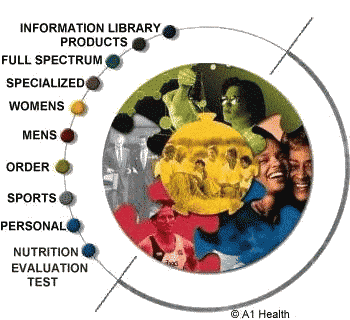COLLOIDAL MINERALS
VITAMIN K
Vitamin K functions in metabolism as a substrate for a microsomal enzyme
that catalyzes the post translational conversion of specific glutamyl residues
in a limited number of proteins to g-carboxyglutamyl
(Gla) residues. The proteins involved include clotting factors II (prothrombin),
VII, IX, and X, plasma proteins C and S, osteocalcin, and matrix Gla protein.
Phylloquinone (2-Me-3-phytyl-1,4-naphthoquinone) from plants and a series of
bacterial menaquinones (2-Me-3-polyisoprenyl-1, 4-naphthoquinone) are natural
forms.
Deficiencies:
The classical symptom of a vitamin K deficiency is a defect in blood coagulation
measured by a one-stage prothrombin time (clinical PT). Uncomplicated deficiencies
are rare. The hemorrhagic disease of the newborn is a potential risk, particularly
for breast-fed infants, but is preventable by vitamin K prophylaxis at birth.
Diet recommendations:
The current Recommended Dietary Allowances (RDAs) for vitamin K are:
|
Age (years) |
µg /day |
| Infants |
0-0.5 |
5 |
|
0.5-1.0 |
10 |
| Children |
1-3 |
15 |
|
4-6 |
20 |
|
7-10 |
30 |
| Adolescents |
11-14 |
45 |
|
15-18 |
55 |
| Adults |
19-24 |
60, female
70 male
|
|
>25 |
65, female |
|
|
80, male |
Past estimates of vitamin K intake were in the range of a few hundred µg/day;
current data suggest that a range of intake of 75-125 mg of phylloquinone/day
is more accurate. The contribution of menaquinones in the lower bowel to satisfying
the human requirement is unknown, but it is probably minor.
Food Sources:
Excellent sources of phylloquinone in the diet are dark green vegetables such
as spinach, broccoli, and kale. These foods may provide more than one RDA in
a single serving. Other green vegetables also furnish significant amounts. Bioavailability
of vitamin K from various food sources has not been established. Meats, grains,
and fruits contribute little vitamin K to the diet, but soybean oil, canola
oil, and olive oil furnish appreciable amounts.
Toxicity:
Large amounts of phylloquinone can be consumed over extended periods with no
toxic effects. Menadione (2-Me-1,4-naphthoquinone) is currently used in animal
feeds but is not longer administered to infants because of resulting hemolytic
anemia, hyperbilirubenemia, and kernicterus.
Recent Research:
A number of reports point to a relationship between vitamin K status and skeletal
health of the elderly. If these findings turn out to be correct, they will open
an exciting new area of research in the field of vitamin K metabolism.
For Further Information:
Suttie, J.W. (1992) Vitamin K and human nutrition. J. Am. Diet. Assoc. 92:
585-590
Suttie, J.W. (1993) Synthesis of vitamin K-dependent proteins. FASEB J. 7:
445-452
Booth, S.L., Pennington, J.A.T. & Sadowski, J.A. (1996) Food sources and
dietary intakes of vitamin K-1 (phylloquinone) in the American diet: J. Am.
Diet. Assoc. 96: 149-154.
RELATED ARTICLES
VITAMIN D Calcium Rickets
Chondroitin Sulfate
& Glucosamine Sulfate
 VITAMIN C: Important for tissue
healing. VITAMIN C: Important for tissue
healing.
 Vitamin
E anti-oxidant Vitamin
E anti-oxidant
 B COMPLEX
VITAMINS B COMPLEX
VITAMINS
 VITAMINS: VITAMINS:
 Super Daily Super Daily
 Formula Plus Formula Plus
 Pre Natal Pre Natal
 Why Minerals
before Vitamins ? Why Minerals
before Vitamins ?
 De-Stress De-Stress
 How do
I know if my side effects are detox symptoms or a potentially serious allergic
reaction?? How do
I know if my side effects are detox symptoms or a potentially serious allergic
reaction??
 Nutrition
Tomato Warning: Nutrition
Tomato Warning:
 US Senate report
in 1936 knew COLLOIDAL MINERALS US Senate report
in 1936 knew COLLOIDAL MINERALS
 Ultra Toddy Ultra Toddy
 MINERAL MUNCH MINERAL MUNCH
 Total Toddy Total Toddy
 Biotin Biotin
 NOTHING
CAN MAKE A MINERAL NOTHING
CAN MAKE A MINERAL
 Disiac Toddy Disiac Toddy
 REQUEST YOUR FREE EAGLE PRODUCT INFORMATION PACK: INFOPACK@eagle-min.com REQUEST YOUR FREE EAGLE PRODUCT INFORMATION PACK: INFOPACK@eagle-min.com

INDEPENDENT
SupraLife Distributor
For personal service Call:
A1 Health
TOLL FREE ORDER EXPRESS HOT LINE :888-441-4184
9 AM Till 7PM EST

e-mail: info@colloidal-min.com
|